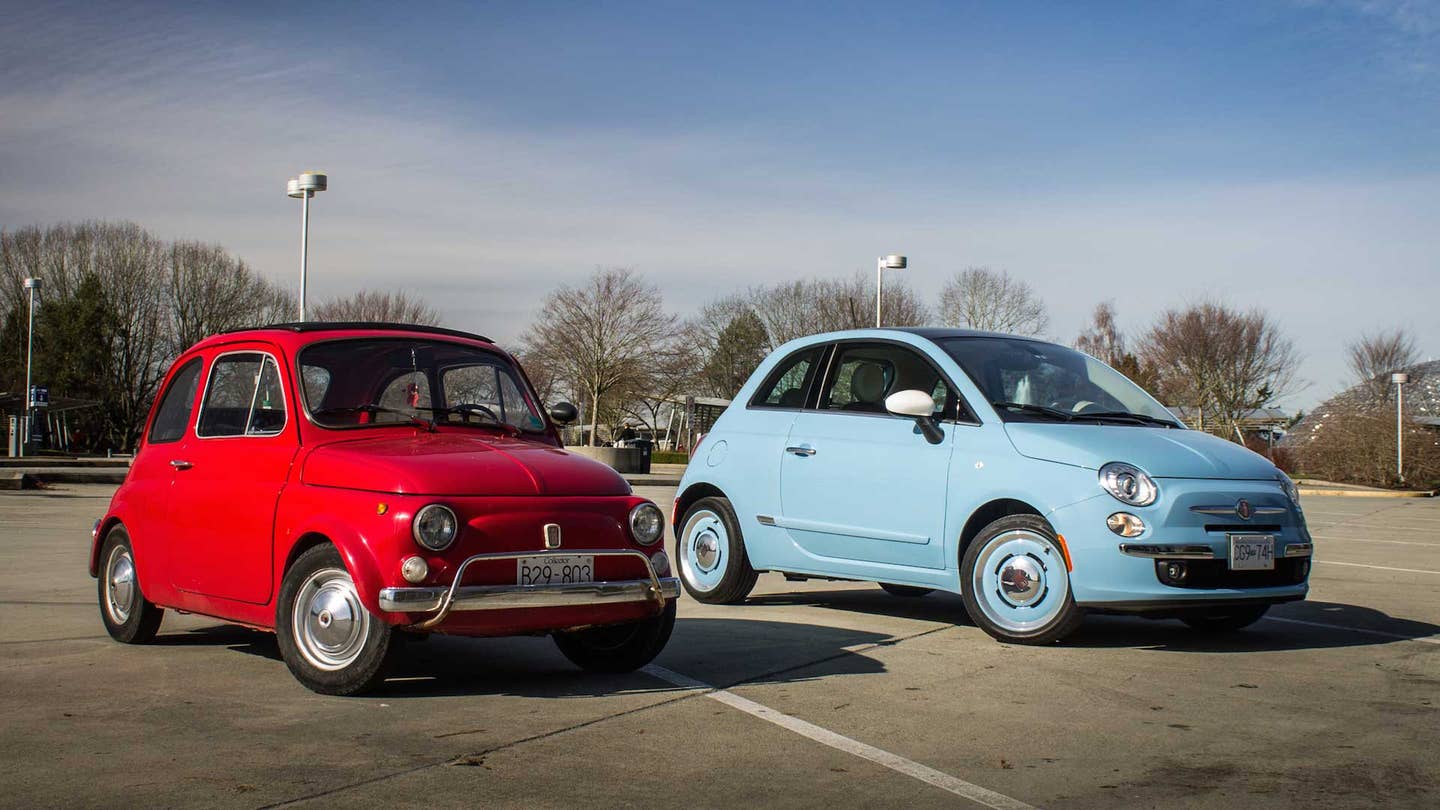2016 Fiat 500 vs. 1972 Fiat 500L
La Dolce Vita meets an artificially sweetened hatchback.

Four decades separate these cars. Four decades, plus a thousand pounds, two feet, eighty-some-odd horsepower, and one overarching philosophy: On the left, we've got the original Cinquecento, the 1972 Fiat 500L; on the right, its would-be descendant, a 2016 Fiat 500, equipped with the ultra retro 1957 equipment package. Old World espresso meets hecho en Mexico instant caffè latte. Audrey Hepburn in Roman Holiday versus Scarlett Johansson in Hail Caesar. They look related. But is the bloodline long past dilution?
Consider Turin, circa 1957, and the birth of the original Fiat 500. Massive loans from the U.S. have spurred an economic miracle, with millions of Italians leaving their rural homes for booming industrial cities. Fascism was dead, the war was over; from the ruins sprang work and hope and bustling city life. The hulking, concrete ark of Fiat's Lingotto factory broke open suddenly, disgorging millions of brightly-colored, people-carrying pods.
When the family outgrew the Vespa, this is what you bought. A flatulent little air-cooled gumdrop with a face like a happy tortoise. It's the most adorable car ever, a personality-crammed runabout that looks like it was sketched by Richard Scarry. If you can resist chuckling at the sight of an original Fiat 500, then you’re probably dead.
This is a 500L. “L” for Lusso, no relation to the Quasimodo-esque four-door lump currently gathering dust in Fiat showrooms, a variants produced during the last few years of the original 500’s production run. Notable upgrades include a fuel gauge and, um, I think the sun visors were extra? This car was all about cheapness and simplicity. Its two-cylinder engine made 16.5 horsepower, its four-speed manual transmission lacked synchros, and its cabin is spare and spartan.
But this is not Sparta. This is Milanese fashion and outdoor cafes and Persol sunglasses and ladies driving around wearing silk headscarves and white gloves. Whip the 500's sixteen horses into a frenzy, and forward progress is sprightlier than expected. Count a three-beat before shifting, or you'll grind third gear like a pound of salsiccia, then weld your right foot to the floorboards and take every corner at speed. This is a momentum car. Don't use the brakes, use your horn.
Climbing into the Mexican-made modern version feels like putting on a fat suit. While the current 500 is small compared to most contemporary cars (including the getting-a-bit-glandular Mini Cooper), it's far lardier than its ancestor, even more than you’d expect. Curiously, the increase in exterior dimensions doesn't translate to a more spacious interior; the original 500 actually feels roomier, thanks in part to its fuller greenhouse.
Blame safety regulations. They demand something with better crash protection than a cardboard pizza box. (Spoilsports.) Blame, too, the trend of modular platform sharing: The Fiat 500 of 2016 is little more than a retro-themed party frock draped over the bones of a Euro-market Ford Ka. It's also not a great drive. The pace is obviously far better than the original, but the too-tall seating position and roly-poly suspension doesn't encourage you to go all con brio. The Abarth models are better, sure, but even a dash of deranged turbocharging can't fix the 500's foibles. It's cute, but compromised.
Maybe we're being unfair. Consider modern Italy: Crowded, congested, besieged by crumbling infrastructure. Fiat's chairman, Sergio Marchionne, has a background in accountancy and a penchant for sweater-vests. The optimism of the postwar Italian economic miracle has been replaced by cautious pragmatism.
And, given that a framework, the window dressing of the modern 500 makes a great deal of sense. Why not gussy up the efficiency of a compact Euro-pod with a few elements of style? With cheap gasoline driving pickup truck and crossover sales, an appeal to nostalgia might mean salvation for the small car market.
But Fiat's business model is hemorrhaging cash. Only half of all Fiat dealers are profitable in the U.S., and there's a new plan to combine them with Jeep-Chrysler dealerships, where the customers (and cash) are. BMW's Mini gambit also continues to falter in North America. So what's the lesson here?
Maybe it's time to be done with the faux-Euro-retro thing. The city car of the future will be self-driving, and the city car of the present is shared. The personal mobility the Cinquecento once represented is far easier to access in due mille sedici. People don't buy people-movers any more, they just get an app.
Arrivederci, Fiat 500. Or, rather: Ciao.
